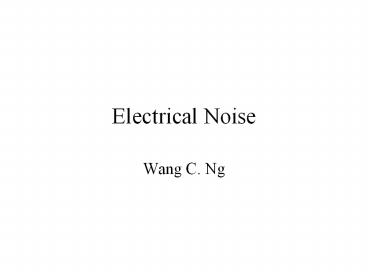Electrical Noise - PowerPoint PPT Presentation
Title:
Electrical Noise
Description:
Flicker noise. Flicker noise is due to contamination and crystal defects. ... flicker noise. Metal film resistors have no flicker ... Flicker noise modeling ... – PowerPoint PPT presentation
Number of Views:390
Avg rating:3.0/5.0
Title: Electrical Noise
1
Electrical Noise
- Wang C. Ng
2
Nature of electrical noise
- Noise is caused by the small current and voltage
fluctuations that are generated internally. - Noise is basically due to the discrete nature of
electrical charges. - Externally generated noise is not considered here.
3
Why study noise?
- It sets the lower limit for the detectable
signals. - It sets the upper limit for system gains.
- Develop mathematical models to take the effects
of noise into account when analyzing electrical
circuits/systems. - Find ways to reduce noise.
4
Thermal noise
- Due to random motion of electrons.
- It is ubiquitous (resistors, speakers,
microphones, antennas, ) - It is directly proportional to absolute
temperature. - White noise - Frequency independent up to 1013 Hz.
5
Thermal noise modeling
- The noise amplitude is represented by the rms
value
6
Thermal noise modeling
- The rms noise voltage for a 1-KW resistor is
about 4 nV/Hz1/2. - The amplitude distribution is Gaussian with m 0
and s vn . - A series voltage source (vn) can be added to a
resistor to account for the thermal noise.
7
Thermal noise modeling
- Examples
- A 1-KW resistor in a system with a bandwidth of
100 MHz generates about 40 mV of noise voltage. - A 1-MW resistor in this system generates about 40
mV of noise voltage. - 10 1-MW resistor in this system generates about
0.4 V of noise voltage.
8
Shot noise
- Shot noise is due to the random arrivals of
electron packets at the potential barrier of
forward biased P/N junctions. - It is always associated the a dc current flow in
diodes and BJTs. - It is frequency independent (white noise) well
into the GHz region.
9
Shot noise modeling
- The noise amplitude is represented by the rms
value
10
Shot noise modeling
- The rms noise current for a diode current of 1 mA
is about 20 pA/Hz1/2. - The amplitude distribution is Gaussian with m
ID and s in . - A parallel current source (in) can be added to a
diode to account for the shot noise.
11
Shot noise modeling
- Examples
- For a diode current of 1 mA in a bandwidth of 1
MHz shot noise generates about 20 nA of noise
current. - For a diode current of 10 mA in a bandwidth of
100 MHz shot noise generates about 2 mA of noise
current. - 100 diodes would generate .2 mA of noise current.
12
Flicker noise
- Flicker noise is due to contamination and crystal
defects. - It is found in all active devices.
- It is inversely proportional to frequency (also
called 1/f noise) . - DC current in carbon resistors cause flicker
noise. - Metal film resistors have no flicker noise.
13
Flicker noise modeling
- The noise amplitude is represented by the rms
value
14
Flicker noise modeling
- The constant K1 is device dependent and must be
determined experimentally. - The amplitude distribution is non-Gaussian.
- It is often the dominating noise factor in the
low-frequency region. - It can be described in more details with fractal
theory.
15
Other noise types
- Burst noise (popcorn noise)
16
System Noise Analysis
- Wang Ng
17
Introduction
- Noise sources can be added to a device models to
represent the effect of noise. - We need a means to characterize the noise
performance of a system (black box). - Noise figure
- Noise temperature
18
Noise figure
- Used for resistive source impedance.
- Most communication systems have a 50-W source
impedance (Thevenin equivalent). - Signal-to-noise (S/N) ratio
- Noise figure F (S/N)in / (S/N)out
- F is a direct measure of the S/N ratio
degradation caused by the system.
19
Noise figure calculations
- For an ideal (noiseless) amplifier
- Sout G Sin
- Nout G Nin
- For a real system
- F (Sin/Nin)(Nout/Sout) Nout/GNin
- or F (Total noise)/(Noise due to input)
- F in in general frequency dependent.
20
System noise
- Internally generated noise can be computed from
- Nsys (F - 1)GNin
- since Nout Nsys GNin
21
Cascade systems
- Gain Gtotal G1 G2 GN
- Noise figure
- Ftotal F1 (F2 - 1)/G1 (F3 - 1)/G1G2
(FN - 1)/G1G2 GN - What does this tell us?
- We should pay most attention to the reduce the
noise of the first system (Why???)
22
Noise temperature
- It is the temperature at which the noise
generated from the source resistance equals to
the system noise. - The noise temperature of a system is a better
measure when F is close to 1 (low-noise system) - Noise temperature Tn T(F-1)
23
Radiometer
- A modern radiometer can measure noise temperature
variation down to 100th or even less in ?K. - This instrument can be used for remote
sensing/imaging. - Possible extra credit presentation.
24
Summary
- System noise measure Noise figure and noise
temperature - Internal noise calculation
- Cascade system noise
- First stage noise































